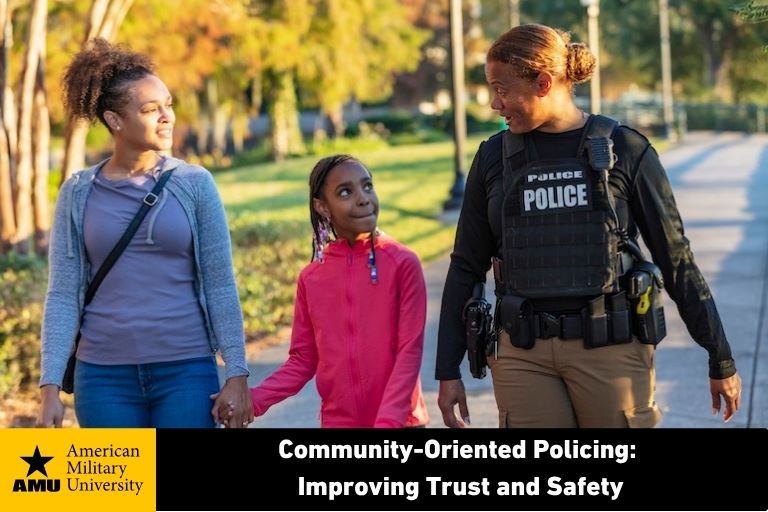By Dr. Matthew Loux and Bryce Loux | 10/28/2025

Community-oriented policing (COP) practices proactive problem-solving and creates partnership between police departments and the communities they serve. It aims to establish proactive policing through:
- Trust building
- Shared responsibility
- Transparency in public safety
In the past, policing has rested on trust and proactive approaches. But to foster a culture of trust in the community, it is necessary to understand community-oriented policing’s current implementation, technological integration, and challenges.
Problem-Oriented Policing: The Precursor to Community-Oriented Policing
In 1979, legal scholar Herman Goldstein created Problem-Oriented Policing (POP) to help prevent crimes. Goldstein, who said that police in a community should focus on problems and solve them, as opposed to waiting for them to escalate. POP later became the precursor to community-oriented policing.
In their 1982 article about “Broken Windows Theory,” political scientist James Q. Wilson and criminologist George Kelling postulated that serious crime may be prevented by first dealing with minor crimes such as vandalism and loitering. By dealing with minor offenses, law enforcement officers demonstrate responsiveness and commitment, as well encouraging community trust in police departments.
The Components of Community-Oriented Policing
Community-oriented policing has several vital components. These components include:
- Community cooperation
- Institutional change
- Reflective practice
Community Cooperation
Community-oriented policing is supported by police departments developing working relationships with residents, businesses, schools, and other community entities. These relationships help to isolate underlying issues with law enforcement, collaboratively design response strategies to crime, and develop mutual rapport.
Institutional Change
Community-oriented policing requires changes in the traditional culture and structure of a police department. Law enforcement officers working in siloed divisions should be authorized to make independent decisions, and policy changes can be made at the divisional level to increase community involvement in crime prevention.
Reflective Practice
Utilizing frameworks such as the Scanning, Analysis, Response, and Assessment (SARA) model community members and police can work together to understand the underlying structures of crime and disorder in their communities. They can then design optimal interventions to reduce local crime rates.
Community Policing in the US
Many law enforcement agencies in the U.S. have widely adopted community policing practices. These practices include:
- Patrolling through neighborhoods as a component of crime prevention efforts
- Hosting community meetings to form community partnerships
- Providing activities for young people, especially from at-risk populations
- Hiring school staff such as security officers or school resource officers
- Creating community advisory panels
The Department of Justice’s Community-Oriented Policing Services Office (otherwise known as the COPS Office) has provided funding for community-oriented policing services and programs in the United States. It has also created community-oriented policing initiatives for both state and federal government agencies.
The Impact of Community-Oriented Policing Services
The community-oriented policing approach to law enforcement can help a community in many ways:
- Neighborhood residents feel safer from violent crimes and other criminal activity in their homes and private businesses, which could be useful in reducing 911 calls.
- Locals have an improved perception of law enforcement agencies' fairness and commitment.
- Police officers feel that community-oriented policing enhances their problem-solving ability and is useful in developing effective solutions for preventing crime.
- The community feels more engaged with local law enforcement agencies and more comfortable with a police presence.
Challenges of Implementing Community-Oriented Policing
In regard to community-oriented policing, law enforcement agencies continue to grapple with several ongoing challenges:
- Resistance to change – Many police departments and other law enforcement agencies struggle with organizational inertia. With the emphasis on hierarchy and control that is predominant in traditional policing models, law enforcement is resistant to community-oriented policing's collaborative, decentralized character.
- Resource limitations – The investment in community policing is significant with regard to training, personnel, and community outreach. As a result, many small police departments lack the necessary resources to effectively implement community-oriented policing.
- Measurement of success – The trust and satisfaction engendered by community-oriented policing is much more complex to quantify than traditional ways of assessing community satisfaction and safety.
- Public skepticism – In communities with a history of abuse or over-policing, trust in law enforcement is scarce. As a result, adopting community-oriented policing initiatives and necessary reforms risk being viewed as performative or superficial by community citizens.
Technology in Community Policing
Over time, technology has played an increasing role in policing. These technology changes include:
- Surveillance and communication tools – The use of body-worn and dashboard cameras by police officers, as well as real-time communication technology, has led to greater transparency and accountability for citizens.
- Predictive policing and artificial intelligence (AI) – The use of AI analytics for crime prediction and pinpointing hot spots has proven helpful for improving resource allocation in law enforcement agencies. However, there are risks to using AI, such as biased information, privacy violations, and over-surveillance issues.
- Social media – Tools like X® (formerly known as Twitter), Facebook®, and Nextdoor® enable the dissemination of information. They also allow feedback to be more easily gathered by law enforcement agencies and could be useful in reducing crime. Also, these sites can build trust and improve communication with citizens.
- Integrated systems – By combining surveillance and communication technologies, police officers and local agencies have experienced more effective results in community-oriented policing.
Recommendations for Adopting Community-Oriented Policing
To integrate community-oriented policing into law enforcement agencies, there are various strategies that could be used:
- Community-oriented policing could be included in a police training module, which would be helpful for law enforcement agencies seeking to reduce crime. This training could emphasize cultural awareness, conflict management, and implicit bias, as well as procedural justice and trauma-informed care.
- Public surveys, complaint data, and crime rate analytics could be collected and used to define accountability.
- Civilian oversight boards, public forums, and advisory councils could be used as a framework for collaborative governance.
- Mental health, housing, and probation services could be utilized to better serve community groups.
The Future of Community-Oriented Policing
Looking beyond the present day, community policing’s prospects rest on integration, technological advancements, and the incorporation of social services and democratic governance. Other possible developments in the future include:
- Youth engagement – Expansion of the Police Athletic League, mentorship, and school partnership programs will be prioritized.
- Health and environmental synergy – Next-generation community policing approaches may include public health and environmental integration.
The Bachelor of Arts in Criminal Justice at AMU
For adult learners interested in studying criminal justice, American Military University (AMU) provides an online Bachelor of Arts in Criminal Justice. For this degree, students will take courses in topics such as criminal investigation, criminology, and ethics in criminal justice. Other topics include U.S. law enforcement, criminal law, and the criminal legal process.
This degree program has four concentrations: marine law enforcement, general, entrepreneurship, and organizational law enforcement leadership. For students who want to learn more about patrol methodologies and community policing, the general concentration may be of particular interest.
For more details, visit AMU’s criminal justice degree program page.
Note: This degree program is not designed to meet the educational requirements for professional licensure or certification in any country, state, province or other jurisdiction. This program has not been approved by any state professional licensing body and does not lead to any state-issued professional licensure.
X is a registered trademark of the X Corporation.
Facebook is a registered trademark of Meta Platforms, Inc.
>
Nextdoor is a registered trademark of Nextdoor, Inc.
Dr. Matthew Loux is a criminal justice faculty member for the School of Security and Global Studies at American Military University. He holds a bachelor’s degree in criminal justice and a master’s degree in criminal justice administration from the University of Central Missouri State, a doctoral degree in management from Colorado Technical University, and a Ph.D. in educational leadership and administration from Aspen University.
Dr. Loux has been in law enforcement for more than 30 years. He has a background in fraud and criminal investigation, as well as hospital, school, and network security. Dr. Loux has researched and studied law enforcement and security best practices for the past 10 years.
Bryce Loux is an alumnus of American Public University. He holds a bachelor’s degree in fire science with a minor in criminal justice. Bryce is currently a student success coach.

